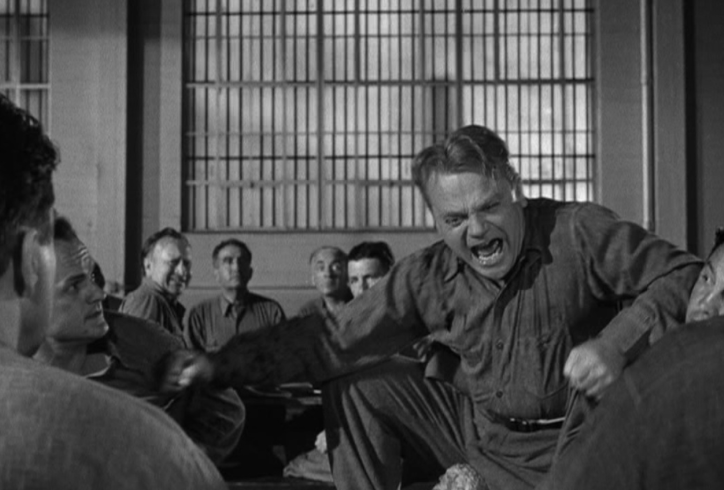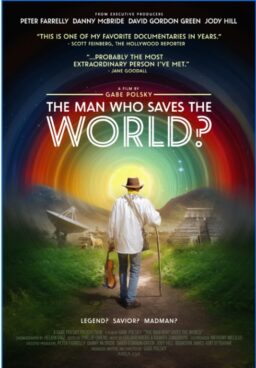“White Heat,” about the final months in a gang leader’s life, is a ruthless tale, ruthlessly told—an artistic peak for its star James Cagney and its director, Raoul Walsh, who had worked on two other features together, the gangster classic “The Roaring Twenties” and the romantic comedy “The Strawberry Blonde.” Their teamwork in this 1949 film is uncanny. Each seems to channel the other. Walsh exemplifies the kind of forceful, unfussy genre directing that was common in the pre-television era but has become increasingly rare over the decades. He found an ideal collaborator in Cagney, a vaudeville dancer-turned-movie star whose work is defined by graceful, direct choices. Each gesture, expression and line reading feels somehow simultaneously real and stylized: Kabuki from the streets. The short, squat, wild-eyed star wasn’t thought of as an innovative or refined actor in his heyday, but his work as leading man (often in gangster pictures) has aged more gracefully than that of his contemporaries, even those acting alongside Cagney in the same films.
“White Heat,” starring Cagney as Cody Jarrett, the mother-fixated, migraine-addled leader of a vicious gang of robbers, is one example. The cast is filled with skilled Hollywood actors, including Virginia Mayo as Cody’s two-timing wife Verna; Steve Cochran as Verna’s lover (and Cody’s right-hand) “Big Ed” Sommers; and Edmond O’Brien as U.S. Treasury Agent Hank Fallon, who goes undercover as “Vic Pardo” to befriend and ensnare Cody. But aside from Margaret Wycherly, who plays the hero’s sainted mom—a character modeled on real-life female gangster Ma Barker—they’re all acting in what would later be considered a style of the time. Cagney exemplifies no style, no school, no academic philosophy. He seems to exist not only apart from fashion but from time itself. Every moment he’s onscreen is an action moment. His feral intensity and lack of pretense made him the leading man equivalent of a drink so stiff that no amount of buildup can prepare you for the impact of that first sip.
Cagney was always thrilling in this kind of film, but his energy is different in “White Heat”—darker, more frightening, that of a villain or monster. You feel it from the very first scene, a train robbery that ends with Cody and his gang murdering four railroad employees in cold blood. Cody kills two of them himself, without hesitation or regret. His behavior is similar to Neil McCauley’s in the opening of Michael Mann’s “Heat.” This character isn’t cut from the same cloth as other movie gangsters. He’s not a volatile, flamboyant antihero that viewers identify with because he plays by his own rules and refuses to bend the knee to the cops and courts and the rich swells. He’s a straight-up psychopath, quick with his fists and guns, resentful of questions and challenges, and distrustful of everyone except for his dear ma—a stone-faced badass who, in a meticulously choreographed, low-speed chase scene, eludes a team of treasury agents trying to tail her. Everyone is terrified of Cody, including characters who insist they aren’t.
Cody, meanwhile, is terrified of his own body. He’s tormented by stabbing pains that course through his mind without warning. The affliction feels almost metaphorical because it’s never medically or psychologically explained; you have to decide for yourself what it means, in a larger sense. When they strike, he grabs his skull, wails in misery, and rolls around on the ground like Shakespeare’s Othello having a seizure. It’s as if the sheer force of his evil destructiveness has boomeranged and struck him in the brain.
Based on a story by Virginia Kellogg, and adapted for the screen by Ben Roberts and Ivan Goff, who had scripted other projects for Cagney, the film’s plot is majestically ludicrous. With law enforcement closing in after the train robbery, Cody decides to create an alibi by pleading guilty to a different crime and doing a brief stint in Illinois State Penetentiary, which is where O’Brien’s character befriends him and sets the stage for the infiltration of Cody’s gang. In theory, he’ll do the time, get out and return to his money, his gang, his wife, and his dear old mum.
The Jarrett gang are gangster cousins of the title characters in Sam Peckinpah’s 1969 Western “The Wild Bunch,” still doing things the old way even as the times pass them by. Like “Psycho,” this is an unpretentious genre movie that is pretty clearly about postwar America but doesn’t feel the need to tell you that. As in another Walsh crime thriller, “High Sierra,” the gangster, an big city archetype, is released into wide-open spaces, like a modern cowboy. But rather than afford him freedom, the big skies and wide horizons oppress him in a different way, in ways he can’t articulate. “White Heat” is set in a world of highways, motels, drive-in movie theaters, and surprisingly, electronics. As in many films made early the Cold War, the story ends with a titanic explosion that assumes the shape of a mushroom cloud. Cody and his men are 1930s characters who are still snarling and preening like a bunch of Pretty Boy Floyd wannabes, four years after the liberation of the concentration camps and the incineration of Hiroshima and Nagasaki. They’re so out of their element that it’s almost comical. The government tries to catch Cody’s gang by eavesdropping on them and tailing them with radar tracking devices. They understand this only slightly better than wolves understand the satellite radio transmitters affixed to their ears by scientists.
The screenplay lays out Cody’s psychology in broad strokes and—as is the case with the criminal tactics—it doesn’t waste time explaining anything that doesn’t need explaining. We buy that “Vic Pardo” would gain the normally hyper-suspicious Cody’s trust, because the undercover copper has studied Cody’s file and knows what buttons to push. All he has to do is save him from a jailhouse murder attempt and nurse him back to health after a migraine attack and bingo, he’s a part of Cody’s inner circle. Walsh and his screenwriters are devilishly playful in how they plant the news that a criminal associate of Cody’s knows that “Vic” is really a cop and then contrive coincidences that will endlessly prolong the revelation. The film is just as narratively audacious when setting up complications (like the affair between Cody’s wife and his chief henchman) and resolving them in surprising ways and at unexpected moments. Both the film and Cody seem capable of anything. That gives the whole picture a low-level electrical crackle, even when the hero isn’t threatening, beating, or shooting people.
At times, “White Heat” feels less like a traditional gangster or cops-and-robbers picture than a criminal cousin of an old Universal Studios horror picture, about a dangerous creature for whom you feel pity, but only up to a point, and who can only roam the countryside for so long, because society can’t abide a threat of such magnitude. The notoriously wild finale, which is known even to people who’ve never seen the rest of the film, is reminiscent of the end of the original “Frankenstein” where the monster is trapped in a burning windmill that collapses and kills him, as well as James Cameron’s two “Terminator” films, which climax in factories whose whirring, clanking gears are nearly as unnerving as the violence meted out by the combatants gathered under its roof. In the end, Cody perishes in a hell of his own making, flames rising around him, screaming to the void that death is vindication.
That the movie presents Cody as so iredeemably destructive, yet somehow makes you feel for him anyway, is the kind of storytelling magic that’s hard to explain or quantify. Thanks to the writing, the filmmaking, and especially Cagney’s performance, you end up caring for this horrendous man, or at least understanding his pain and the demons that drive him. And when he’s at his lowest—as when a piece of bad news in prison causes him to wail like an animal with its neck caught in a steel trap—you may wish you could reach out to Cody, even though you know he’d slap your hand away, or shoot a hole through it. Cody may not have reached the top of the world, as he screamed to his ma, but everyone involved in “White Heat” was operating at the top of their game.












